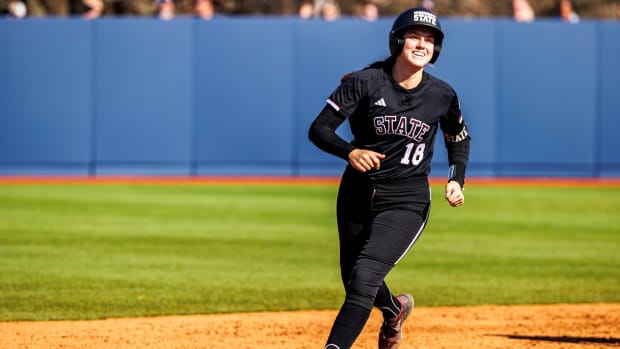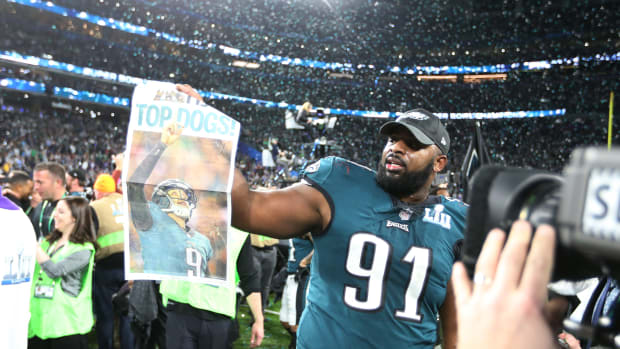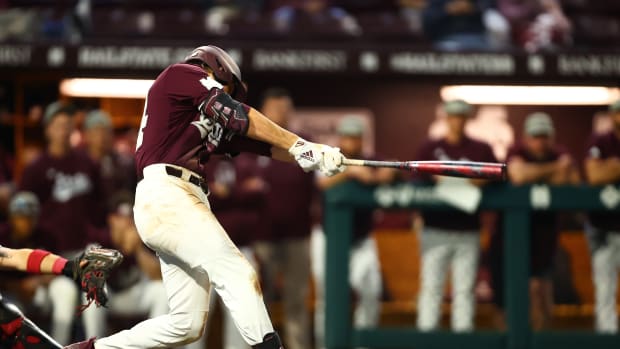“We are who we are”: MSU receivers are about to be counted on like never before
It has been said before, more than once, that numbers don’t tell the whole story. That’s true in many cases. When you’re talking about how head coach Mike Leach’s air-raid offense is going to change Mississippi State football like never before though – well, it looks like the numbers say it all.
About three months remain before the Bulldogs are slated to play their first game under Leach. Since Leach was hired in January, folks have heard the air-raid offense talked about. Many have probably seen it in action in Leach’s previous head coaching stops at Texas Tech and Washington State over the course of the last two decades. But now, it’s getting closer to time for the Leach system to make its maroon and white debut. And make no mistake about it, the numbers insist it’s unlike anything Mississippi State has done before.
That means, for it all to work, the Bulldogs are going to be counting on receivers, both now and in the future, to be more vital than ever at MSU.
“That’s a fun stat”
If you’ve watched Mississippi State football at all in the recent past, you’ve seen that the Bulldogs haven’t exactly lit up the world with their production at receiver. Forget about dropped passes or missed opportunities. Sure there has been some of that, but the Bulldogs just weren’t built for offensive success through the air much of late.
Former head coach Dan Mullen ran a spread offense, but it was based on the run. Then Joe Moorhead took over for Mullen and in year one, had a run-first quarterback in Nick Fitzgerald before last year when arguably Moorhead’s best passer (Tommy Stevens) dealt with injury and Stevens’ backup, Garrett Shrader, was a dual-threat guy who was still learning the college game as a true freshman.
All that is a long-winded way to say this – passing hasn’t exactly been MSU’s weapon of choice lately. Meanwhile it has been option A, B and C for Leach over the course of his coaching career. The statistics put up by wide receivers under Leach compared to those at MSU of late says it all.
In the last decade, all the way back to the 2010 season, Mississippi State has only had nine different 500-plus yard seasons by a receiver. The Bulldogs haven’t had any – not one – in the last three years.
Meanwhile at Washington State, Leach’s receivers had seven guys reach 500 yards receiving…LAST YEAR ALONE.
Mississippi State outside receivers coach Steve Spurrier, Jr., who was also with Leach at Washington State, says he loves talking about that last stat.
“When you tell people that, that gives them an idea that who we’ve been is who we’ve been,” Spurrier Jr. said. “Who we are and what we’re going to bring is a bunch of guys who plan on catching it and throwing the ball for a bunch of yards here. That’s a fun stat. That’s clear on what Mississippi State has been and what we hope to be going forward.”
Historical what-ifs
Keep digging into those stats a little bit. Let’s simply look at Washington State last year. If you could transplant the Cougars’ numbers into the Mississippi State record book from last season alone, Washington State players would already make up 40 percent of MSU’s Top 10 all-time best single-season performances in terms of receptions. Again, that’s just looking at one season of the Leach offense.
In terms of yardage, Washington State had two players in 2019 who, with their numbers, would be in MSU’s Top 5 all-time in single season receiving yardage. In fact, Washington State receiver Brandon Arconado with his 1,109 receiving yards last season would easily have set MSU’s record for most receiving yardage ever in a season, topping the would-be old mark by 74 yards. Just to emphasize it once more, this is looking at only one season alone of the Leach offense, and if you moved the numbers from this one season over to State, it would rewrite the MSU record book.
It seems safe to say current MSU receivers Osirus Mitchell, JaVonta Payton, Malik Heath and the rest are soon going to get the real opportunity to quickly etch their names among State’s all-time statistical leaders.
They’re going to get the ball thrown to them and it’s going to happen time and time again. It’s just what Leach does. In his 18 years as a head coach, Leach’s passing offense has finished No. 11 in the country or better every single season. In nine of those years, it was No. 1. In 15 of those 18 years, it was inside the Top 5.
Could these type of numbers actually be put up at Mississippi State – a school that has only twice in its history had a quarterback pass for more than 3,000 yards and only once ever had a season with more than 4,000 team passing yards, both numbers that Leach offenses eclipse pretty much on a yearly basis?
“That’s who we are and that’s who we’ve been and that’s to be expected,” Spurrier, Jr. said. “We are who we are. We’re going to do what we do. It’s not going to be running the ball much. It’s not going to be quarterback-run driven. We’re going to throw it. There’s no grey area in what we’re going to do.”
Getting it going
Last season, Leach threw the football about 77 percent of the time at Washington State. In 2018, he threw it about 71 percent of the time. In 2017, the football was in the air about 70 percent of the time.
It’s basic math, but looking at the recent past, it stands to reason MSU is about to pass on about three out of every four plays.
Compare that to what State has done in its last three years. In 2019, the Bulldogs passed on only about 37 percent of their plays. State threw it around 39 percent of the time in 2018 and about 36 percent of the time in 2017 – so roughly over the last three years, State has passed once every three plays or so. That is almost assuredly now going to at least double.
Again though, a critical part of all this working comes down to receivers catching the football and making plays. Is this air-raid attack something all MSU receivers can pick up on quickly and master? Leach has said in the past he can install his offense quickly and Spurrier Jr. seems to think the Leach style of practice lends itself towards State’s pass-catchers quickly getting a grasp of things.
“We practice what we do,” Spurrier Jr. said. “We don’t practice a bunch of things we don’t do. We don’t change what we practice week to week. We’re very consistent on what we’re doing, how we do it and how we practice. I think that gives us a huge benefit and lets guys get comfortable with what we’re wanting to do.
“(Our receivers’ routes are) not terribly specific to areas of the field. We don’t have a route that tells you to run here and him to run there and I’ve got to run there and you read the defense and throw to one of those areas of the field. There’s a lot of emphasis on plays that are pretty good against a lot of different coverages. That does help a lot. And we practice that a lot. We practice running the same plays against all kinds of different coverages and looks and just continuing to find a way to get open. That’s what we practice. That’s how we do it. Guys get comfortable with that and they kind of learn how to do it.”
What about the future?
Mississippi State basically knows what it has to work with in 2020 as it tries to get the Bulldog version of the Leach air raid up and running. Mitchell and Heath and Payton and Austin Williams and the newcomers and everyone else will get their shot to make this thing take off in Starkville.
But what about beyond this year? It certainly seems like an offense that is going to throw the ball as much as Leach and company would be awfully attractive to top receivers.
Currently, MSU has one receiver committed in the Class of 2021 and that’s Brandon Buckhaulter out of Hartfield Academy in Flowood. He’s a three-star recruit per the 247Sports composite ranking and he’s the state of Mississippi’s ninth-best overall prospect.
Meanwhile the Bulldogs are reportedly in the game with several other top receiving targets including four-star pass catchers Theodore Knox, Malik Nabers and Keon Coleman. All three of those guys are ranked among the Top 50 receivers in the country.
A pass-happy offense, in theory, bodes well for Mississippi State as it looks to bring in top receivers in the future. There’s one small problem for the Bulldogs though. They haven’t shown this offense works in Starkville yet. That’s the next step for State.
“The presence of this offense always gets recognized,” Spurrier Jr. said. “When we call and tell (recruits) who we are and what we’ve done and show them the data and show them the stats and show them the numbers, everyone is excited to see that. But on the same note, we have to put that product on the field. We have to show that there are people wearing Mississippi State helmets that are running around and catching the ball. We haven’t done that yet. There’s still a lot of unknowns on who we are. Mike Leach comes in from Washington State and some people know about him and some people don’t. Here’s the air-raid system – (people say), ‘Well, I’m curious.’ Curiosity is really high for all these receivers and quarterbacks.
“But for the majority of our really big-time receivers, they want to see it. They want to see the product on the field.”
If the numbers indeed tell the whole story, it’s not a matter of if Leach’s air raid takes off in Starkville. It’s only a matter of when.
“Give Leach a lot of credit for what he’s done and how he’s done it,” Spurrier Jr. said. “He’s put together a framework and a system that can be successful and has been.”




